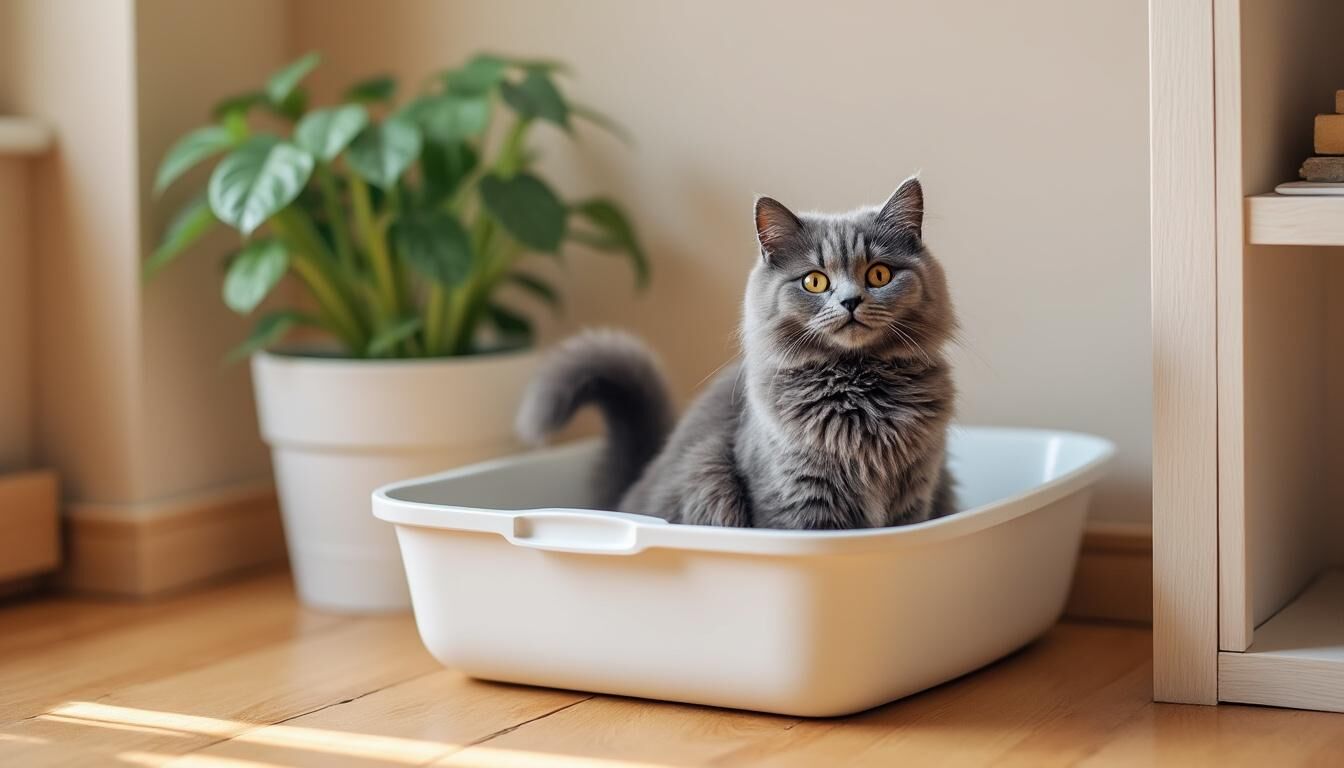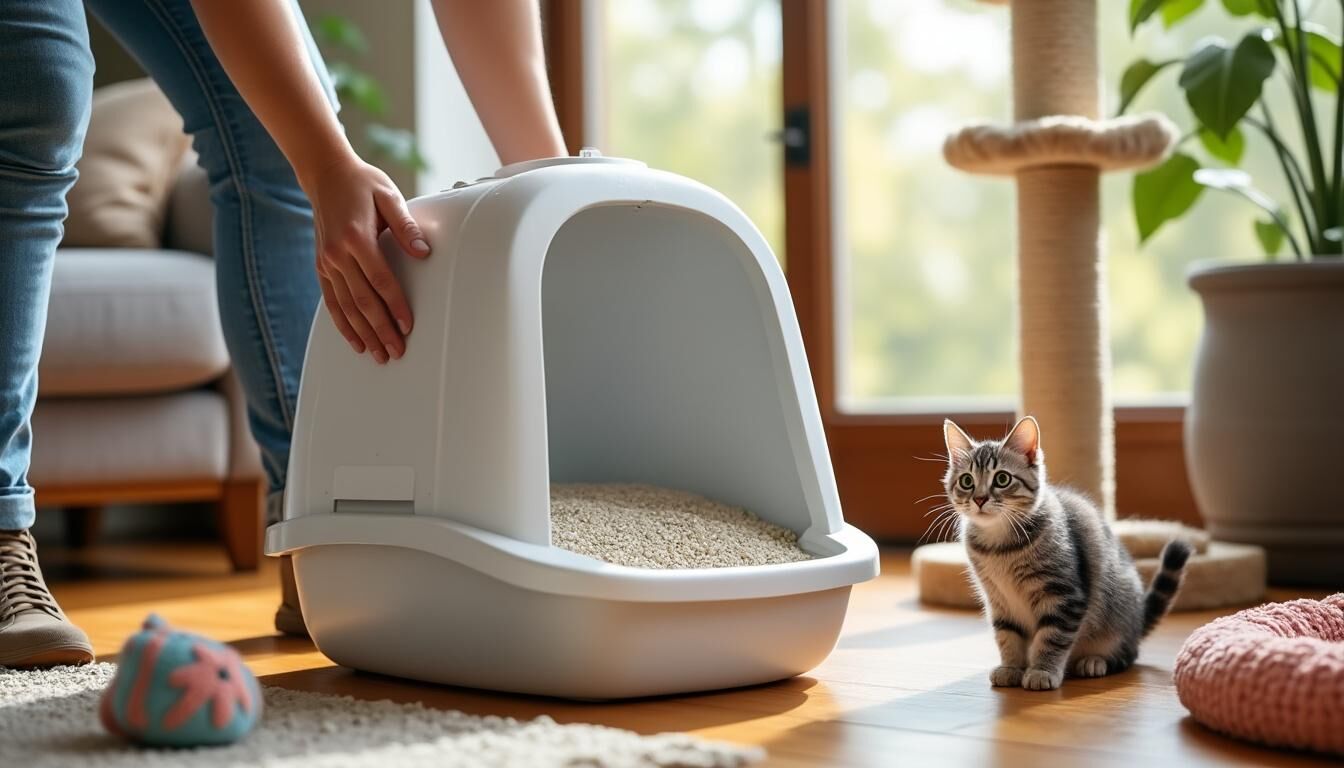Moving a cat’s litter box might seem like a simple household chore. However, for cats, whose lives revolve heavily around routine and familiar environments, such a change can create significant confusion and stress. Cats rely on consistent cues in their environment, and a sudden move can disrupt their sense of security, leading to undesirable behaviors such as accidents outside the box or even aversion to the new location. Therefore, understanding the feline behavioral nature is essential when planning to relocate the litter box, as well as choosing an optimal place that prioritizes the cat’s comfort and safety. This article will carefully guide readers through the process of moving their cat’s litter box with patience, positive reinforcement, and practical steps to ensure a smooth transition with minimal stress for their beloved feline companions. 🏡🐾
Understanding Your Cat’s Routine Before Moving the Litter Box
Why Cats React to Litter Box Location Changes
Cats are creatures of habit with a strong preference for routine. Their ability to mark and recognize their territory depends significantly on spatial familiarity and olfactory cues linked to their litter box. When the location changes abruptly, cats often experience disorientation. Because the litter box is not only a place for toileting but also a key marker in their living space, relocation can disrupt their behavior patterns. This can lead to behavioral signs of anxiety such as vocalizing, pacing, or avoiding the box altogether.
For example, in multi-cat households, sudden relocation of one or multiple boxes can cause confusion and even territorial disputes as cats interpret the change as an invasion. In one case study, a cat refused to use her new litter box site for several days until careful scent-transfer and gradual adjustment were applied. Cats’ sensitivity to change means that owners must approach moving the litter box with understanding and care.
-
Strong association between scent and place 🐱
-
Relies on spatial memory and habit 🧠
-
Perceives change as a threat or disruption 🔄
-
May react with avoidance or marking outside box 🛑
How Sudden Litter Box Relocation Can Cause Stress
Sudden moves can lead to acute stress responses in cats. Stress elevates cortisol levels which not only impacts behavior but can affect overall health. Owners might observe a reluctance to use the litter box or even physical symptoms like excessive grooming or hiding.
The risk of stress-related litter box avoidance is a serious concern, as prolonged avoidance can result in urinary tract infections or other health complications. These risks emphasize why a gradual transition is critical to minimize anxiety and maintain the cat’s trust and comfort.
|
Common Signs of Stress During Litter Box Relocation 🐾 |
Possible Consequences ⚠️ |
|---|---|
|
Avoidance of litter box |
Accidents outside the box and sanitation issues |
|
Excessive vocalizations |
Communication of distress or confusion |
|
Hiding or withdrawal |
Reduced appetite and decreased social interaction |
|
Changes in grooming habits |
Skin irritation or secondary infections |
How to Choose the Best New Spot for Your Cat’s Litter Box
Cat-Friendly Litter Box Placement: Quiet, Safe, and Accessible
Choosing the right location for the cat’s litter box involves prioritizing comfort and minimizing stress. The box should be placed in a quiet area, away from high traffic zones, loud household appliances, or busy hallways where the cat might feel threatened or distracted. Privacy is crucial as cats prefer discrete spots to do their business without feeling exposed.
Accessibility is another key point, especially for older or less mobile cats. The box must be easy to reach without obstacles that could cause frustration or deter use. Additionally, it’s best to keep the litter box away from feeding and watering stations to avoid sanitation concerns and maintain the cat’s natural behavioral separation of eating and toileting areas.
-
Choose a quiet corner away from noises like washers or fans 🔇
-
Ensure the spot is well-ventilated to reduce odors 🍃
-
Keep the litter box away from food and water bowls 🍽️🚰
-
Maintain clear and safe paths to the box, without obstacles 🚪
-
Consider household routines and avoid busy locations during peak family activity 👨👩👧👦
Special Considerations for Older or Less Agile Cats
Older cats or those with mobility impairments need extra thought when selecting a new litter box location. Litter boxes with lower sides can facilitate easier entry. The placement should avoid stairs or rough terrain within the home. A location nearby their favorite resting spots can help encourage consistent use. Lighting is also important — some elderly cats have diminished vision and prefer gently lit spaces. For those with joint issues, a softer surface near the box can aid their comfort.
-
Choose low-profile litter boxes for easy entry 🚪
-
Place boxes on the same floor to avoid stairs ⬇️
-
Use soft mats or rugs around the box placement area 🧸
-
Check for draft-free and comfortably warm places 🌡️
-
Monitor closely during the transition for signs of reluctance or pain 🩺
Step-by-Step Guide: Gradually Moving Your Cat’s Litter Box
Phased Transition: Using Two Litter Boxes During the Move
One of the most effective ways to minimize stress when moving a litter box is by adopting a phased approach. Initially, add a second litter box at the desired new location while maintaining the original box in its place. This dual setup gives the cat the possibility to explore and adjust at their own pace, rather than forcing a direct abrupt change.
This phase can last from several days up to a few weeks depending on the cat’s temperament. Gradually, begin to move the original litter box closer to the new spot by small increments — a matter of inches or a few feet each day. This slow migration reduces disorientation and reinforces familiar marking with the scents the cat trusts.
-
Start by placing a second litter box in the new location 🆕
-
Keep both boxes clean and accessible 🚿
-
Slowly move the original box closer to the new spot, inch by inch ↔️
-
Monitor the cat’s behavior closely during this period 👀
-
Remove the old box only when the cat consistently uses the new one 🚮
Preserving Familiar Scents to Support Adjustment
Smell plays a fundamental role in feline behavior. Transferring a portion of used litter or placing some soiled paper towels from the old box into the new one can provide familiar scents that comfort the cat and encourage acceptance.
Why Keeping the Same Litter and Box Matters
Changing the type of litter, the litter box model, and its location all at once can overwhelm a cat. It is highly advisable to keep the same litter type and box during the entire moving process, avoiding suddenly switching brands or introducing scented litters that might add to the cat’s confusion.
Consistency in these elements limits the variables that cause anxiety. In fact, mixing familiar litter with fresh litter helps maintain the olfactory cues that the cat identifies with. This method has been corroborated by cat behaviorists and veterinary professionals who recommend gradual adjustments to safeguard feline well-being.
|
Do’s for Scent Transfer and Litter Consistency 🌿 |
Don’ts to Avoid for Smooth Transition ❌ |
|---|---|
|
Use some used litter in the new box |
Avoid changing litter brand or texture suddenly |
|
Keep the same box type/shapes |
Do not move the box abruptly to a distant area |
|
Maintain familiar cleaning products around box |
Don’t introduce scented litter without testing |
|
Observe cat’s reactions and adjust pace if necessary |
Resist replacing box or litter multiple times simultaneously |
Positive Reinforcement and Monitoring During Litter Box Transition
How to Encourage Your Cat with Treats and Praise
Positive reinforcement is key to fostering smooth adaptation. Rewarding the cat with treats, gentle petting, or praise immediately after using the new litter box helps create positive associations with the new location. This reinforcement motivates cats to repeat the desired behavior and reduces resistance.
Maintaining a consistently clean litter box environment is essential. Cats are fastidious creatures and a dirty or smelly litter box will discourage usage regardless of location. Frequent scooping and changing the litter at recommended intervals support the cat’s willingness to engage with the new spot.
-
Offer favorite treats right after successful use 🍖
-
Use gentle praise and affection 🥰
-
Keep the box spot clean and odor-free regularly 🔄
-
Observe and reward even small steps of progress 👏
Warning Signs of Litter Box Aversion or Stress
Monitoring the cat closely during the transition period helps catch early signs of stress or aversion, preventing long-term behavior problems. Warning signs include frequent vocalization near the box, refusal to enter, urinating or defecating outside the box, or increased hiding. A sudden change in eating habits or aggression may also signal problems that warrant attention.
If adverse behaviors persist, consulting a veterinarian or professional cat behaviorist is essential to rule out medical conditions or underlying psychological issues. This approach ensures well-being and addresses concerns with a personalized plan.
|
Warning Signs of Litter Box Stress😿 |
Potential Actions to Take ✔️ |
|---|---|
|
Avoids new litter box location |
Return temporarily to old location, slow the transition |
|
Accidents or elimination outside box |
Increase positive reinforcement, monitor health |
|
Increased hiding or vocalization |
Provide safe spaces and reduce household noise |
|
Changes in appetite or aggression |
Consult veterinarian or cat behaviorist |
Expert Tips, Special Scenarios, and Emerging Litter Box Trends
Managing Multiple Cats: Litter Box Placement Strategies
In households with several cats, litter box placement requires additional planning to prevent territorial conflicts and ensure access for all. Experts recommend providing one litter box per cat plus one extra. Boxes should be spaced in different quiet locations to reduce competition.
For multi-cat families, placing boxes at various points around the house can minimize stress while promoting individual comfort. Such distribution also reduces the chance of litter box bullying, which may prompt some cats to avoid the box or eliminate elsewhere.
-
Provide at least one litter box per cat plus one extra ➕
-
Place boxes in separate quiet, low-traffic areas 🏠
-
Ensure easy access to boxes for all cats 🚪
-
Observe interactions near litter boxes carefully 🐾
Smart Litter Boxes and Eco-Friendly Solutions for Modern Cat Owners
In recent years, the market has seen innovative litter boxes designed to improve hygiene and reduce owner effort, such as smart litter boxes with automated scooping, odor control, and even health monitoring capabilities. Many cat owners find these devices helpful to maintain a consistently clean and pleasant litter environment.
Eco-conscious owners also seek eco-friendly litters made from sustainable materials like recycled paper, corn, or wood pellets that minimize environmental impact without compromising cat comfort. Some brands available on platforms like Amazon offer a variety of such options that align with modern household values while enhancing litter box experience.
-
Smart litter boxes with self-cleaning functions 🤖
-
Health monitoring features alerting to urinary issues 🩺
-
Eco-friendly litters made of biodegradable materials 🌱
-
Litter box furniture for privacy and aesthetic appeal 🛋️
-
High-sided boxes reduce litter tracking and spills ✋

Frequently Asked Questions
How far can I move a litter box without causing problems?
Ideally, move the litter box gradually over several days or weeks, relocating it just a few inches at a time. Sudden moves that involve long distances inside the home or between floors can cause confusion and resistance.
What if my cat refuses to use the new litter box location?
Ensure the new location is quiet, private, and accessible. Use familiar litter and box smells, positive reinforcement, and consider reverting temporarily to the old setup to help your cat feel comfortable. If refusal persists, consulting a cat behaviorist or veterinarian is advisable.
Is it okay to move the litter box to a different floor in the house?
Moving the litter box to a different floor can be challenging for some cats, especially older or less agile ones. It should be done gradually, ensuring easy accessibility and safe paths. Some cats may never adjust well, so monitor behavior closely throughout the transition.
How long does it typically take a cat to adjust to a new litter box location?
Adjustment times vary depending on the cat’s temperament and consistency of the transition process. Most cats can adapt within a week or two with proper gradual moving techniques and positive reinforcement.
How can I reduce litter tracking during and after the move?
Use litter mats around the box to catch excess litter, choose litter with larger granules or non-tracking formulas, and maintain frequent cleaning. High-sided litter boxes also help minimize spills during use.

